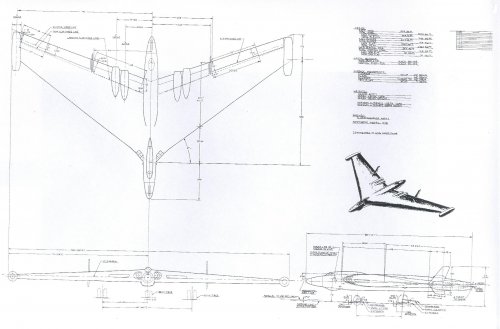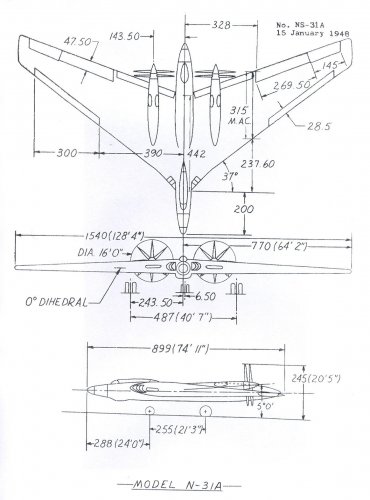The first advanced Northrop combat flying wing from the 1940s-early 1950s interval that is worthy of discussion is the N-31 medium bomber. Even before the second YB-49 crashed over Muroc Dry Lake in June 1948, Northrop was starting to realize that it would have to start anew with novel flying wing bomber designs that could theoretically correct problems inherent in earlier Northrop flying wings like the B-35 and B-49 if it hoped to convince the US Air Force of the viability of flying wing bombers. With the Soviet Union having detonated its first nuclear weapon in present-day Kazakhstan in August 1949, Northrop was eager to develop a flying wing bomber with a bomb bay big enough to carry America's available nuclear weapons and ultimately the in-development hydrogen bomb. Multiple flying wing bomber and reconnaissance designs with either turbojet or turboprop engines were investigated under the N-31 company designation with two, four, or six engines.
 |
| 3-view drawing of the Westinghouse J40-powered N-31, with accompanying specification at the top right corner |
 |
| 3-view drawing from Northrop company documents of N-31A design with two Allison T40 turboprop engines. Note the absence of upright vertical stabilizers. |
 |
| Northrop N-55 (left) and N-55A (right) design studies for a long-range patrol flying wing |
Northrop's study of advanced combat flying wings in the 1940s and early 1950s was not confined to bomber aircraft. Prior to the cancellation of the RB-49, Northrop looked at the potential of the flying wing to be used for long-range patrol missions. With the US Air Force promulgating an across-the-board scheme to improve American air defense systems, which partly led to the WS-201 (aka 1954 Interceptor) requirement that resulted in development of the delta-winged Convair F-102 Delta Dagger and F-106 Delta Dart as well as the trisonic Republic XF-103 Thunderwarrior, the Northrop company adapted the YB-49 airframe into a design for a patrol plane under the designation N-55. The wingspan of the N-55 would be same as that the B-35 and B-49, but the fuselage design would mirror that of the N-31 flying wing designs in utilizing fore and aft crew nacelle extensions, giving the plane a length of 61.8 feet (18.8 meters). The N-55 concept was basically not just intended for long-range patrol missions but also would serve to function as an airborne radar picket ship that could fire air-to-air missiles against enemy planes that intruded into North American airspace. As noted by Chong (p. 66), search radars operating in the X-band or S-band ranges would be internally accommodated in the nose and tail of the N-55. Two N-55 variants were studied, the baseline N-55 powered by two Northrop XT37-NA-3 turboprops each delivering 10,000 hp and armed with 44 AAM-N-2 (later GAR-1/2/3/4/5/6/9 and finally AIM-4) Falcon air-to-air missiles (of which a dozen would be fired from leading edge tubes with eyelid covers, the rest being housed in two weapons bays), and the N-55A using six Westinghouse J40 turbojets. The turboprop-powered N-55 looked like a cross between the baseline N-31 and later N-31A versions because it had two T37 turboprop engines and a pair of vertical stabilizers, while the engine arrangement of the N-55A resembled that of the YB-49, with the jet engines buried between two pairs of vertical stabilizers on the wing's trailing edge.
But the N-31 and N-55 flying wing studies were all for naught, despite offering potential remedies to the stability and range problems that made the YB-49 unsuitable as a bombing platform and ineligible to carry large nuclear and thermonuclear weapons. Continued concerns about longitudinal instability of flying wings combined with evolving air defense priorities meant that the N-31 and N-55 were never green-lighted for full-scale development by the US Air Force, so they remained paper projects only.
References:
Buttler, T., 2010. American Secret Projects: Bombers, Attack, and Anti-Submarine Aircraft 1945-1974. Hersham, UK: Ian Allan Publishing.
Chong, T., 2016. Flying Wings & Radical Things: Northrop's Secret Aerospace Projects & Concepts 1939-1994. Forest Lake, MN: Specialty Press.
Rose, B., 2010. Secret Projects: Flying Wings and Tailless Aircraft. Hersham, UK: Ian Allan Publishing.




No comments:
Post a Comment